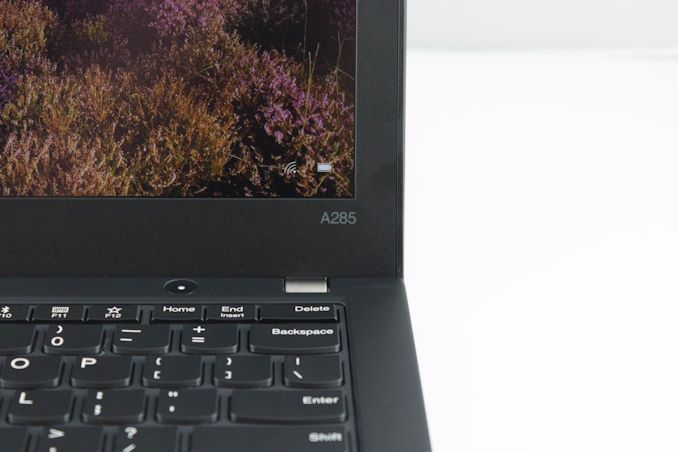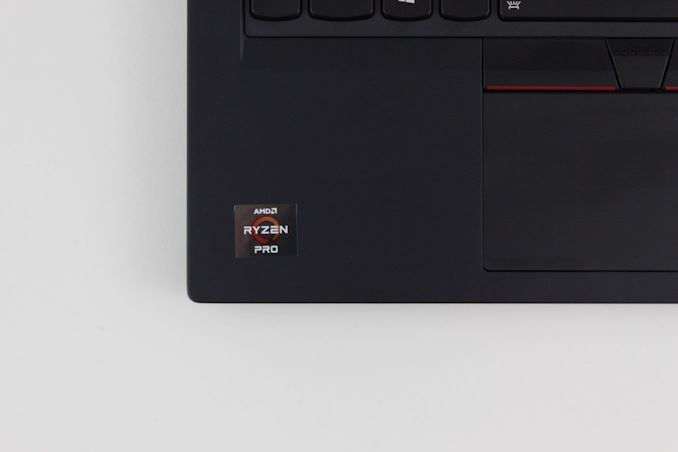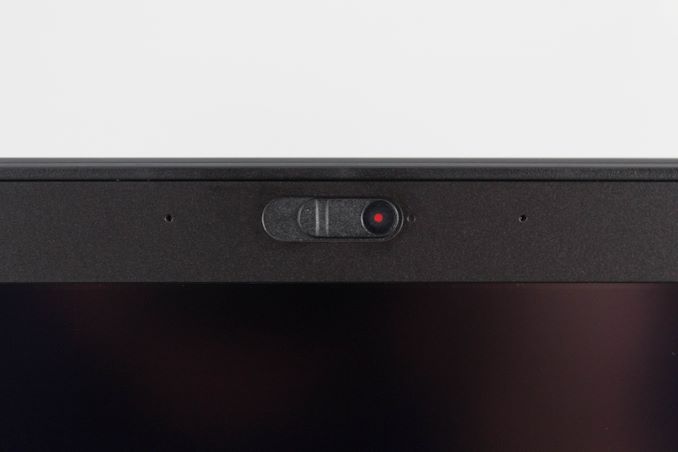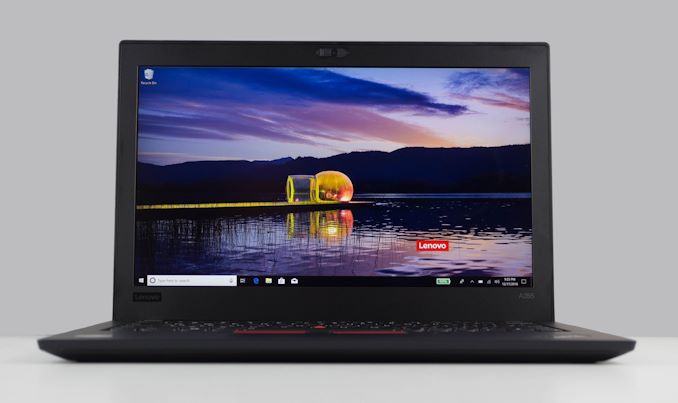The Lenovo ThinkPad A285 (12.5-Inch) Review: Ryzen Pro Gets Down to Business
by Brett Howse on December 18, 2018 8:00 AM EST- Posted in
- Laptops
- AMD
- Lenovo
- ThinkPad
- Vega
- Ryzen
- Ryzen PRO
- Ryzen Mobile
- Vega Mobile
Final Words
If you are in the market for a premium business-class Ultrabook featuring AMD’s Raven Ridge platform, Lenovo has you covered with the ThinkPad A285. The build quality is as superb as you’d expect in a ThinkPad, and it offers a great keyboard with a thin and light design. The ThinkPad look is iconic, and despite the A285 not being as leading edge as Lenovo’s X1 Carbon design, the A285 offers a great build for far less than what an X1 Carbon costs.
It would be nice to see Lenovo ditch the low-end 1366x768 TN display option, even though there is likely demand for it by people buying in bulk for other people to use. But in practice the 1920x1080 IPS should be a pretty easy upsell; it offers a much higher resolution, along with an anti-glare coating, and touch support, making it a rather compelling option. The color accuracy of the IPS display is only average, but that is likely not a huge issue for the target demographic for this device.
It’s unfortunate to see this chassis move away from the removable dual-battery system. Dual batteries were a great idea, since you could easily swap out the battery without shutting down the machine. But Lenovo likely has metrics on how often that was used, and you can generally get a larger battery in less size if you go with a non-removable model. As a business machine, parts should not be an issue either.
Lenovo offers great connectivity with the ThinkPad A285, including two USB-C Gen 2 ports, an integrated Ethernet connector, and a clever combination of the Ethernet and USB-C port to offer a docking option. There’s no SD card reader, but there’s likely not a huge demand for that in a laptop not aimed at photographers. Lenovo does cover the business requirements with a fingerprint reader, as well as a smart card reader.
The performance of the Raven Ridge-based AMD Ryzen 5 Pro 2500U is not spectacular though, and even the kind of performance advantage you'd expect from an AMD iGPU are not really there with the Vega 8 iGPU. Although on the whole the overall performance is more than adequate for plenty of office tasks. The 8 GB of RAM is enough for today for the type of tasks you’d likely perform on a 12.5-inch laptop, but it would really be nice to see a build-to-order 16 GB option on Lenovo’s site as well. The larger 14-inch A485 does offer up to 32 GB.
The biggest thorn in an otherwise solid laptop is probably AMD’s platform power draw. We’ve only tested two Raven Ridge laptops so far, but the idle power draw of each was remarkably consistent, falling within 40 mW of each other. And at over 4.5 Watts, it's just too high, causing significantly higher battery drain than their competitors. This, coupled with the 48 Wh battery in the ThinkPad A285, means that we achieved battery runtimes that were well below the category average. That’s not ideal for a device that is so easily portable. Lenovo offers this same chassis with the Core i7-8650U, and undoubtably the battery life would be significantly better with the Intel platform.
Despite the issues with AMD’s mobile platform, there’s little doubt there is demand for their products, and for those in the market for a well-built Ryzen Mobile laptop, it’s hard to look further than this. If your business is interested in devices with DASH support, AMD’s Ryzen Pro series has you covered with open-source device management, comparable with Intel’s vPro offerings. Lenovo is offering a great product featuring AMD Ryzen, with a quiet and reliable design, plenty of business features, and a laptop that is incredibly easy to travel with. Hopefully AMD can sort out its power issues soon, and make their product more competitive in such a competitive design as this Lenovo ThinkPad A285.














72 Comments
View All Comments
jardows2 - Tuesday, December 18, 2018 - link
This chassis is not too thin for an Ethernet port. Our organization just ordered in a bunch of HP probook 450's that are every bit as thin as this, and they all include an Ethernet port. To make Ethernet connectivity a dongle is just a stupid business decision made by Lenovo for this class of laptop.HStewart - Tuesday, December 18, 2018 - link
It not that thin of notebook, it include Type-A USB so it still fat notebook - I would think it possible to include ethernet at back part of it - probably a cost saving measure - just like the display.IGTrading - Tuesday, December 18, 2018 - link
I find it ridiculous that the reviewers felt the unexplained need of including 15" laptops and notebooks with a discrete video card and compared them with a 12.5" Thin&Light portable without a discrete GPU.Why the heck are we comparing plums to grapes and apples to pineapples ?!
The most basic journalistic "rules" for an initial review are to compare products priced similarly and of course, products with comparable specifications.
Does anybody care to compare a Lamborghini to a Ford K ? Sure those are both cars, both use petrol and both have 4 wheels ... but really !?!
You want to have an expert comparison between similar products from DIFFERENT product lines .... to show just how much extra performance does a larger chassis bring ... or a higher price ... ok, do it and present it as such.
Here's a 12" ThinkPad with X CPU vs a 15" ThinkPad with the same X CPU (or similar) and here is the extra performance the larger and more expensive product gets you.
But why the heck would you compare a 15" Microsoft Surface 2 with a discrete GPU costing 2300 USD with a 12.5" ThinkPad with just an APU (no discrete GPU) costing half the price ?!?!
Is this to bury the good test results of Lenovo's AMD-based ThinkPad and make it look mediocre ?!
If Ford launches a new Ford K ... what kind of reviewer will compare it and test it against the newest Ferrari ?!
This is being forced (on all reviewers) by Intel's PR team. You either do it, or next time you have ZERO access to anything Intel-related. (happened to me too, many years ago)
nico_mach - Tuesday, December 18, 2018 - link
It doesn't seem to have a great analogue in these numbers, true. But it is very close to the Surface Pro i5 results, which is much thinner and lighter, so it still doesn't look good. Unfortunately, the prices aren't listed in these performance results - so the dGPU and i7 that look so good aren't really in the same league, but we don't know by how much.The results are unfortunate, but this is still progress by AMD, considering where they were 2 years ago. And getting Intel to respond the way they have - buying AMD graphics, matching their core counts, moving on with a hybrid 10nm scheme - really shows how competitive they've become. And when was the last time Intel had to resort to dirty tricks? Unfortunately I think both Intel and AMD should worry more about Quallcomm and Apple than each other. This comparison is ultimately irrelevant.
DanNeely - Tuesday, December 18, 2018 - link
Adding the 1060 was arguably gratuitous; but all the fanboiing on the Ryzen mobile had been about how it was going to crush the competition so Intel's mainstream parts and NVidia's entry level MX150 are entirely appropriate. And Lenovo's performance here is just awful. With 8 clusters of GPU cores instead of 10 it should be able to do at least 80% of the performance of the 15W Ryzen 7 in the Swift 3 (and a bit closer should be expected since it can use its TDP to clock the GOU higher); but instead it's coming in around 2/3rds.StevoLincolnite - Tuesday, December 18, 2018 - link
There is allot of issues in regards to Ryzen mobile, drivers and TDP.In some instances, limiting the CPU will allow the GPU in the 2500u to run faster than the 2700u.
I have the Lenovo E585 myself with a Ryzen 2700u. - It does Overwatch, 60fps, 1080P at 56% scaling all settings low.
The driver situations is certainly bullshit though, my notebooks drivers are months out of date... AMD doesn't offer any newer revision... And if I "work around" the drivers and install unofficial ones, windows update will override it at a later date and downgrade them.
I honestly expected more out of it... Going to upgrade the Ram to 16GB with lower latencies and hope that might make a small difference. My next notebook will certainly have a discreet GPU.
IGTrading - Wednesday, December 19, 2018 - link
Yes, the mobile driver for Ryzen needs work and needs it quick. If OEMs don't give a crap about their customers and offer no decent support, AMD should step in with a Beta mobile driver. Doesn't need to be WHQL, doesn't need anything special ... just offer it.As for testing in exactly the same conditions, HP x360 has Ryzen and Intel models in the same chassis. When tested these two, AMD Ryzen trounced the Intel model.
Hul8 - Tuesday, December 18, 2018 - link
It's helpful to have the *one* token example with a discrete GPU, so readers can tell how much you give up by going integrated. Otherwise the review would be in a bubble of similarly handicapped systems.HStewart - Tuesday, December 18, 2018 - link
My comment was nothing about Intel - your response falsely assume it was.Most notebook users use notebook for word processing, spreadsheets and such and don't need descret CPU.
What does the GPU matter in comment about USB Size? I had to look up the specs to see what specs it had - is Vega 8 even descrete GPU? it not part of discussion - just falsely assume it was bias statement.
MonkeyPaw - Tuesday, December 18, 2018 - link
I agree when it comes to some of the performance tests. The dGPU model really skews the graphs by being so much better than iGPU models. Makes a comparison of similar models harder to do.